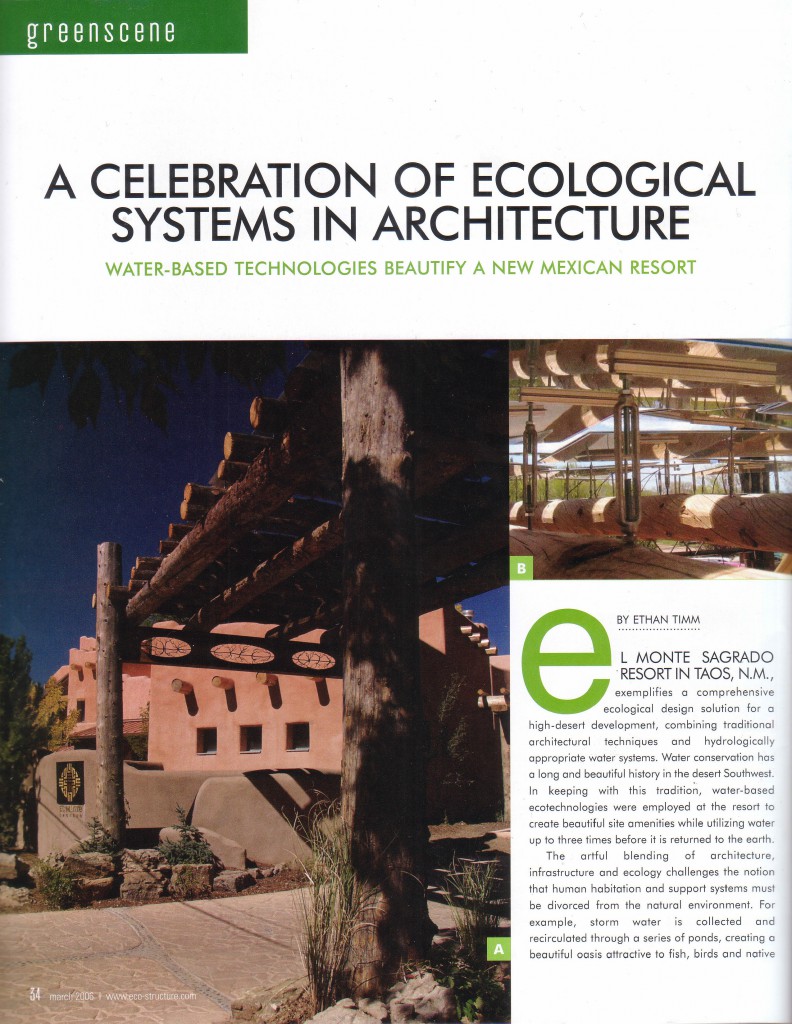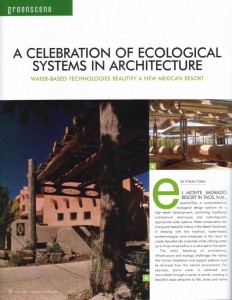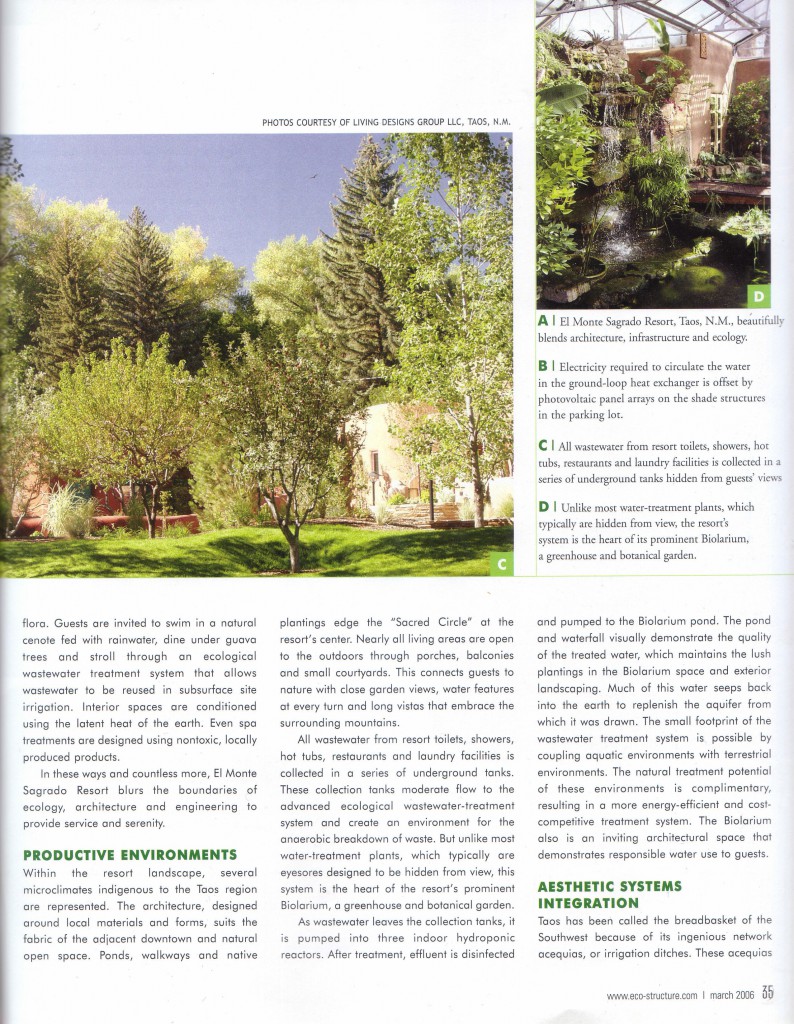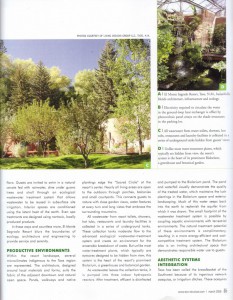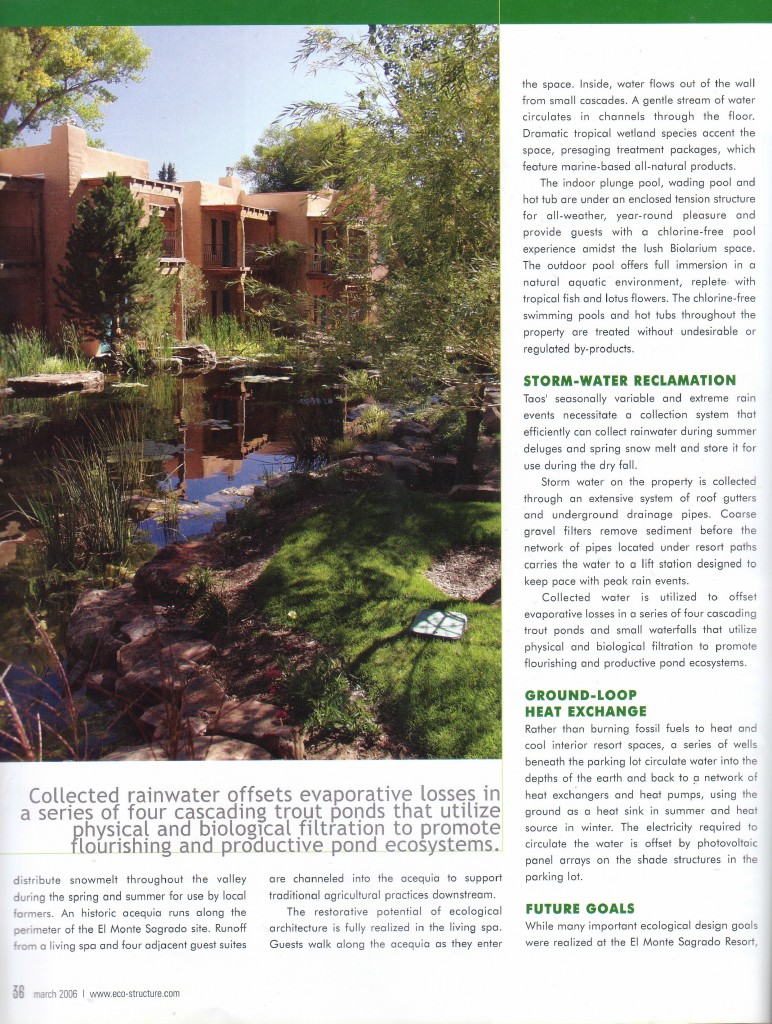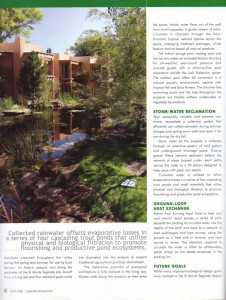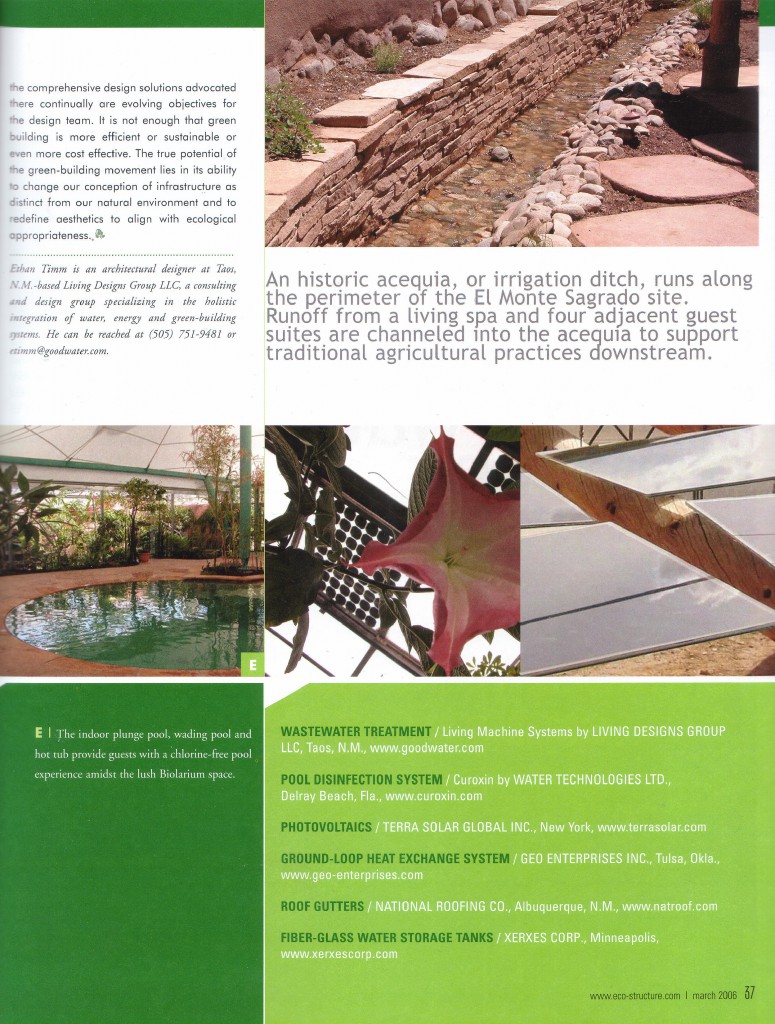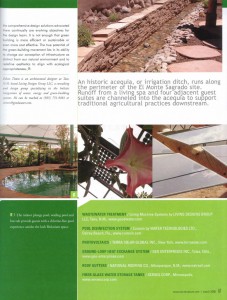A Celebration Of Ecological Systems In Architecture

[THIS ARTICLE WAS FIRST PUBLISHED IN 2006]
WATER-BASED TECHNOLOGIES BEAUTIFY A NEW MEXICAN RESORT
BY ETHAN TIMM
EL MONTE SAGRADO RESORT IN TAOS, N.M., exemplifies a comprehensive ecological design solution for a high-desert development, combining traditional architectural techniques and hydrologically appropriate water systems.
Water conservation has a long and beautiful history in the desert Southwest. In keeping with this tradition, water-based eco-technologies were employed at the resort to create beautiful site amenities while utilizing water up to three times before it is returned to the earth.
The artful blending of architecture, infrastructure and ecology challenges the notion that human habitation and support systems must be divorced from the natural environment. For example, storm water is collected and recirculated through a series of ponds, creating a beautiful oasis attractive to fish, birds and native flora. Guests are invited to swim in a natural cenote fed with rainwater, dine under guava trees and stroll through an ecological wastewater treatment system that allows wastewater to be reused in subsurface site irrigation . Interior spaces are conditioned using the latent heat of the earth. Even spa treatments are designed using non-toxic, locally produced products. In these ways and countless more, El Monte Sagrado Resort blurs the boundaries of ecology, architecture and engineering to provide service and serenity.
PRODUCTIVE ENVIRONMENTS
Within the resort landscape, several microclimates indigenous to the Taos region are represented. The architecture, designed around local materials and forms, suits the fabric of the adjacent downtown and natural open space. Ponds, walkways and native plantings edge the “Sacred Circle” at the resort’s center. Nearly all living areas are open to the outdoors through porches, balconies and small courtyards. This connects guests to nature with close garden views, water features at every turn and long vistas that embrace the surrounding mountains. All wastewater from resort toilets, showers, hot tubs, restaurants and laundry facilities is collected in a series of underground tanks. These collection tanks moderate flow to the advanced ecological wastewater-treatment system and create an environment for the anaerobic breakdown of waste. But unlike most water-treatment plants, which typically are eyesores designed to be hidden from view, this system is the heart of the resort’s prominent Biolarium, a greenhouse and botanical garden.
As wastewater leaves the collection tanks, it is pumped into three indoor hydroponic reactors. After treatment, effluent is disinfected and pumped to the Biolarium pond. The pond and waterfall visually demonstrate the quality of the treated water, which maintains the lush plantings in the Biolarium space and exterior landscaping. Much of this water seeps back into the earth to replenish the aquifer from which it was drawn. The small footprint of the wastewater treatment system is possible by coupling aquatic environments with terrestrial environments. The natural treatment potential of these environments is complimentary, resulting in a more energy-efficient and cost-competitive treatment system. The Biolarium also is an inviting architectural space that demonstrates responsible water use to guests.
AESTHETIC SYSTEMS INTEGRATION
Taos has been called the breadbasket of the Southwest because of its ingenious network of acequias, or irrigation ditches. These acequias distribute snowmelt throughout the valley during the spring and summer for use by local farmers. An historic acequia runs along the perimeter of the El Monte Sagrado site. Runoff from the living spa and four adjacent guest suites are channeled into the acequia to support traditional agricultural practices downstream.
The restorative potential of ecological architecture is fully realized in the living spa. Guests walk along the acequia as they enter the space. Inside, water flows out of the wall from small cascades. A gentle stream of water circulates in channels through the floor. Dramatic tropical wetland species accent the space, presaging treatment packages, which feature marine-based all-natural products. The indoor plunge pool, wading pool and hot tub are under an enclosed tension structure for all-weather, year-round pleasure and provide guests with a chlorine-free pool experience amidst the lush Biolarium space. The outdoor pool offers full immersion in a natural aquatic environment, replete with tropical fish and lotus flowers. The chlorine-free swimming pools and hot tubs throughout the property are treated without undesirable or regulated by-products.
STORM-WATER RECLAMATION
Taos’ seasonally variable and extreme rain events necessitate a collection system that can efficiently collect rainwater during summer deluges and spring snow melt and store it for use during the dry fall.
Stormwater on the property is collected through an extensive system of roof gutters and underground drainage pipes. Coarse gravel filters remove sediment before the network of pipes located under resort paths carries the water to a lift station designed to keep pace with peak rain events. Collected water is utilized to offset evaporative losses in a series of four cascading trout ponds and small waterfalls that utilize physical and biological filtration to promote flourishing and productive pond ecosystems.
GROUND-LOOP HEAT EXCHANGE
Rather than burning fossil fuels to heat and cool interior resort spaces, a series of wells beneath the parking lot circulate water into the depths of the earth and back to p network of heat-exchangers and heat pumps, using the ground as a heat sink in summer and heat source in winter. The electricity required to circulate the water is offset by photovoltaic panel arrays on the shade structures in the parking lot.
FUTURE GOALS
While many important ecological design goals were realized at the El Monte Sagrado Resort, the comprehensive design solutions advocated ere continually are evolving objectives for the design team. It is not enough that green building is more efficient or sustainable or even more cost effective. The true potential of the green-building movement lies in its ability change our conception of infrastructure as
distinct from our natural environment and to (re)define aesthetics to align with ecological appropriateness.

